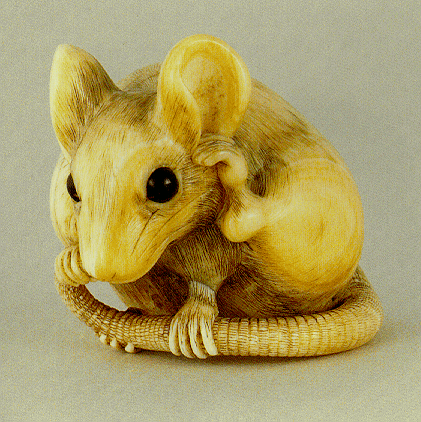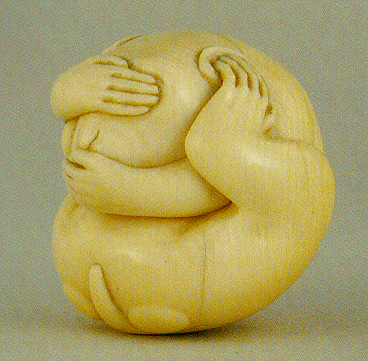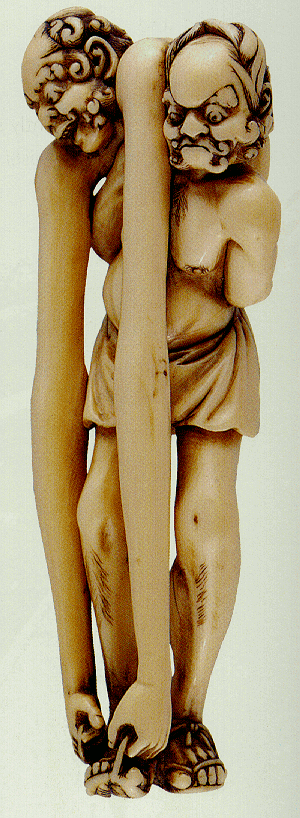Psyco 482
homepage
Netsuke |
 This figure of a rat appearing on the Psychology 482 homepage is a picture of a Japanese netsuke (pronounced net-skay). This netsuke measures 3.8 x 4 cm, and was carved in the eighteenth century by an artist named Masanao (of Kyoto). The rat is the first sign of the Asian zodiac, representing the beginning of things. Rat netsuke would be carried for good luck and prosperity.
This figure of a rat appearing on the Psychology 482 homepage is a picture of a Japanese netsuke (pronounced net-skay). This netsuke measures 3.8 x 4 cm, and was carved in the eighteenth century by an artist named Masanao (of Kyoto). The rat is the first sign of the Asian zodiac, representing the beginning of things. Rat netsuke would be carried for good luck and prosperity.
The pictures of netsuke shown here are all taken from Joseph Kurstin's Netsuke. Story Carvings of Old Japan, a publication (1994) accompanying a wonderful museum display of Mr. Kurstin's netsuke collection currently on display at the Japanese pavilion at Epcot Center, Walt Disney World.
 As an artwork, netsuke are unique to Japan where, from the seventeenth through nineteenth centuries, they were worn as a part of the traditional Japanese clothing, the kimono. Because kimono have no pockets, small objects were carried in boxes, called sagemono (literally, "hanging object"). Sagemono took many forms: inro were lacquered cases for cosmetics, medicines, or seals, kinchaku were money cases, and tabako-ire were tobacco cases. The sagemono were suspended from a cord passed behind the obi, the sash holding the kimono closed. The netsuke served as the counterweight, attached to the other end of the cord, thereby preventing the sagemono from falling through the obi. The sagemono on the left is an inro made by the famous seventeenth century lacquer artist Ritsuou. Japanese lacquer work is unique in Asia, involving the sprinkling of gold and silver powder onto the surface. Lacquer art was extremely difficult; one inro could take years to be completed. The inro on the left (11 x 8 cm) displays a falcon tied to a perch shaped as a demon's head. The opposite side of the inro (not shown) depicts a Korean ship, echoed by the netsuke of a ship (4 x 6 cm).
As an artwork, netsuke are unique to Japan where, from the seventeenth through nineteenth centuries, they were worn as a part of the traditional Japanese clothing, the kimono. Because kimono have no pockets, small objects were carried in boxes, called sagemono (literally, "hanging object"). Sagemono took many forms: inro were lacquered cases for cosmetics, medicines, or seals, kinchaku were money cases, and tabako-ire were tobacco cases. The sagemono were suspended from a cord passed behind the obi, the sash holding the kimono closed. The netsuke served as the counterweight, attached to the other end of the cord, thereby preventing the sagemono from falling through the obi. The sagemono on the left is an inro made by the famous seventeenth century lacquer artist Ritsuou. Japanese lacquer work is unique in Asia, involving the sprinkling of gold and silver powder onto the surface. Lacquer art was extremely difficult; one inro could take years to be completed. The inro on the left (11 x 8 cm) displays a falcon tied to a perch shaped as a demon's head. The opposite side of the inro (not shown) depicts a Korean ship, echoed by the netsuke of a ship (4 x 6 cm).
 Netsuke were carved from all sorts of material, including ivory, sea shells, rock, and wood. The frog (12 x 3 cm), shown to the right, was carved by Kokusai in the nineteenth century, from a piece of stag antler. The himotoshi, or cord channel, through which the cord suspending the sagemono would pass, is clearly visible between the frog's front feet. The monkey (below) depicting the admonition to see no evil, hear no evil, and speak no evil, was carved by the nineteenth century artist Kaigyokusai in ivory.
Netsuke were carved from all sorts of material, including ivory, sea shells, rock, and wood. The frog (12 x 3 cm), shown to the right, was carved by Kokusai in the nineteenth century, from a piece of stag antler. The himotoshi, or cord channel, through which the cord suspending the sagemono would pass, is clearly visible between the frog's front feet. The monkey (below) depicting the admonition to see no evil, hear no evil, and speak no evil, was carved by the nineteenth century artist Kaigyokusai in ivory.

 Besides animals, the supernatural served as a popular source of inspiration in netsuke art. Traditionally, the Japanese loved ghost stories. Their mythologies and legends are filled with tales of ghosts and spirits. Ghosts are often depicted with long hair, flowing clothes, beckoning hands, and bodies trailing away in mists. Here (left) is a beautifully carved netsuke of a woman's ghost (9.5 x 2.5 cm) carved of box wood by an unknown artist in the nineteenth century.
Besides animals, the supernatural served as a popular source of inspiration in netsuke art. Traditionally, the Japanese loved ghost stories. Their mythologies and legends are filled with tales of ghosts and spirits. Ghosts are often depicted with long hair, flowing clothes, beckoning hands, and bodies trailing away in mists. Here (left) is a beautifully carved netsuke of a woman's ghost (9.5 x 2.5 cm) carved of box wood by an unknown artist in the nineteenth century.
 Along with ghosts, goblins, and other nasties, the Japanese mythos is also filled with supernatural creatures and gods who had greater or lesser powers for good or evil. The netsuke to the right (11 x 3.7 cm), carved by Miwa, an eighteenth century artist, represents the two figures Ashinaga and Tenaga. The story of Ashinaga and Tenaga goes as follows. Once there were two tribes who lived on opposite sides of a river in China. Both were poor because they caught few fish. One tribe, the Ashinaga, had long legs and short arms; they could enter deep water, but not reach the fish. The other tribe, the Tenaga, had the opposite problem; their arms were long, but their legs were short. Only when the tribes began cooperating with a member of the Ashinaga carrying a Tenaga on his shoulders did the two tribes prosper.
Along with ghosts, goblins, and other nasties, the Japanese mythos is also filled with supernatural creatures and gods who had greater or lesser powers for good or evil. The netsuke to the right (11 x 3.7 cm), carved by Miwa, an eighteenth century artist, represents the two figures Ashinaga and Tenaga. The story of Ashinaga and Tenaga goes as follows. Once there were two tribes who lived on opposite sides of a river in China. Both were poor because they caught few fish. One tribe, the Ashinaga, had long legs and short arms; they could enter deep water, but not reach the fish. The other tribe, the Tenaga, had the opposite problem; their arms were long, but their legs were short. Only when the tribes began cooperating with a member of the Ashinaga carrying a Tenaga on his shoulders did the two tribes prosper.